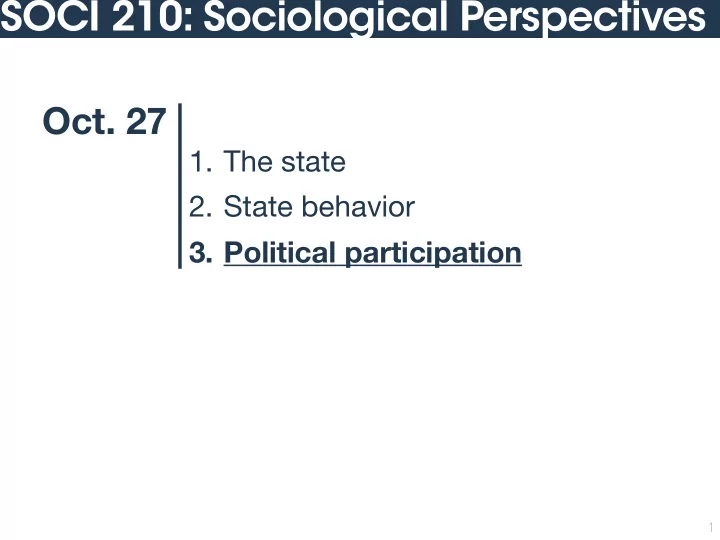

SOCI 210: Sociological Perspectives Oct. 27 1. The state 2. State behavior 3. Political participation 1
Political Participation 2
Political participation Many types of political participation ⦙ Voting ⦙ Direct participation E.g. running for office ⦙ Collective pressure E.g. committees and interest groups ⦙ Direct action E.g. strikes, occupations, marches, sabotage, service, … ⦙ Money E.g. campaigns, influence, bribery, … Social categories matter ⦙ Associations between social identity and political ideals mean turnout influence outcomes ⦙ Non-participation widespread In US, most likely voters are wealthy, older, educated, employed, and White ⦙ Non-participation results from preferences and institutional barriers In US, most likely voters are wealthy, older, educated, employed, and White 3
Democratic will Politics and social E.g.: Democrat vs Republicans identity (US, 2016) ⦙ Political ideals tend to ⦙ Republicans disproportionately : correlate with social White, men, straight, protestant/ evangelical Christian, upper-middle categories class ⦙ Gender, race, ethnicity, ⦙ Democrats disproportionately : nationality, sexuality, Non-white, women, LGBTQIA+, religion, … agnostic/atheist or Jewish, lower class ⦙ Black Americans ~20x more likely Democrat than Republican 4
Democratic will Disenfranchisement ⦙ Commonly, certain groups are excluded from voting, either formally or informally. Historically : race, gender, … Currently : age, citizenship, imprisonment, location, … ⦙ Suffrage : the legal right to vote in elections Informal means often limit electoral participation among certain groups ⦙ Literacy tests exploit correlation between education and political positions ⦙ Voter ID laws exploit correlation between socio-economic factors and political positions ⦙ Polling place accessibility laws exploit correlation between ability/geography and political positions 5
Political participation Voter turnout in Canada (percent) Federal elections and referendums, 1960–2015 80 Voter turnout 75 70 65 60 1960 1970 1980 1990 2000 2010 Year Source: Elections Canada 6
Theories of political participation Rational choice theory Theories of socializaton ⦙ Political economy ⦙ Democratic participation is learned ⦙ Necessary to know the norms and ⦙ Voter decisions based on costs procedures of political and benefits engagement ⦙ RT predicts extremely low turnout ⦙ Knowledge of government processes Engagement with politicians Sources of news Understanding of formal and informal voting practices Structural barriers Alienation ⦙ Structural constraints can explain ⦙ Lack of trust in political institutions most patterns of voter turnout ⦙ Legitimacy of state in question ⦙ Time ⦙ Voting as implicit endorsement of Employment, family structure, access to transit system of governance ⦙ Geography Non-participation as voice Location of polls, rural versus urban setting, ⦙ Voter suppression neighborhood Misinformation, unequal resources, districting ⦙ Language patterns, voter intimidation Ballots and instructions, get-out-the-vote ⦙ Structural barriers ➝ alienation initiatives 7
Image credit Photo: April Sikorski Photo: Politico via Getty Print: Gustin, E. W (1901) 8
Recommend
More recommend